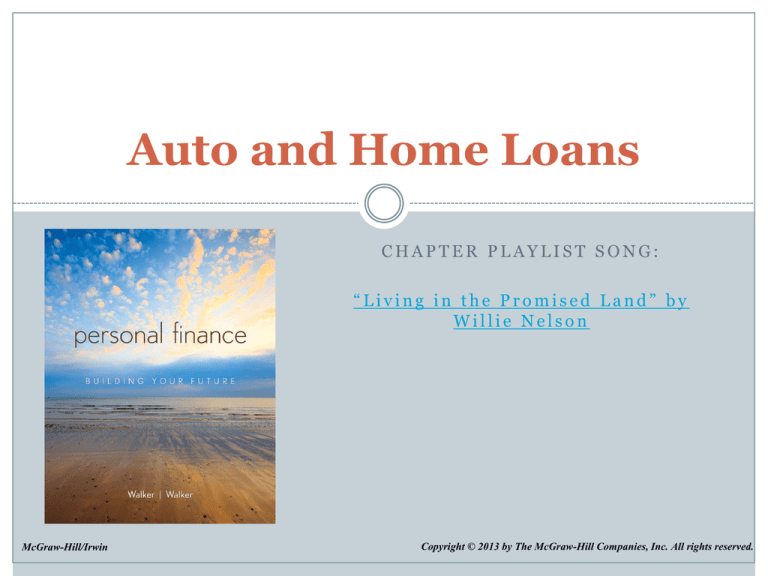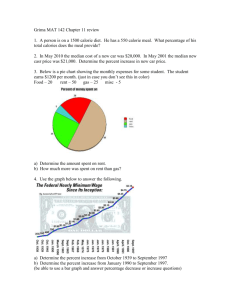
Auto and Home Loans
CHAPTER PLAYLIST SONG:
“Living in the Promised Land” by
Willie Nelson
McGraw-Hill/Irwin
Copyright © 2013 by The McGraw-Hill Companies, Inc. All rights reserved.
Learning Objectives
LO 7-1 Recognize how to get the best deal when
purchasing a car, compare purchase vs. lease
options, and gain an understanding of the
loan approval process.
LO 7-2 Compare buying vs. renting a home and
evaluate which stage in life is best to make
this investment.
7-2
Learning Objectives, ctd.
LO 7-3 Describe the steps involved in purchasing a
home, including financing options, and
discuss the mortgage refinancing decision.
LO 7-4 Explain how home equity loans are used and
describe the precautions that need to be
taken when using them.
7-3
Auto and Home Purchases
One of your largest purchases
You need to do your homework
Research comparable purchases for both home and auto
Research the reliability and repair cost for autos
Research the builder’s reputation and construction practices
Ask yourself, Is it better to buy new, buy used, lease, or rent?
Find what you want
Negotiate the price
Close the deal
7-4
Steps of the Auto Purchase
7-5
Step 1. Analyze Needs vs. Wants
7-6
Step 1: Analyzing Needs vs. Wants
In America, your image and personality are often
tied to the car or truck you drive.
Do you need 4-wheel drive or just “want” it?
What does driving a Jeep communicate to others?
What does driving a hybrid or all-electric vehicle say about
you?
Review your values
Needs are different from wants
Determine your driving habits and vehicle needs
7-7
Need vs. Want Questions
How much cargo do you carry?
How far do you drive on a daily basis?
Do you drive highway miles or in town?
What type of driving experience do you want?
Do you want the wind blowing through your hair riding
in a convertible or something that will keep you warm in
the winter?
Are you looking for speed, acceleration, and handling, or
fuel economy?
Do you prefer manual or automatic transmission?
How important is a GPS and/or entertainment system?
Do you need two-wheel drive, all-wheel drive, or fourwheel drive?
7-8
Step 2: Determine What You Can Afford
7-9
Step 2: Determining What You Can Afford
Keep total debt-to-income ratio at 36% or less
7-10
Step 3: Do Your Homework
7-11
Step 3: Do Your Homework
Research new and used vehicles - meet needs/wants
Most new cars depreciate 35% - 40% in the 1st 3 years
Used cars
Have an independent mechanic inspect it
Research online for dependability, repair rate, reliability, and
price
New cars
Warranty – 36 months, 36,000 miles
Lower interest rates
Latest safety features
7-12
7-13
Leases
Long-term rental agreement (2-3 years)
Limit on miles driven
Early termination fee
7-14
7-15
Cost of Leasing vs. Buying: An Automobile Comparison
7-16
Step 3: Do Your Homework
Determine a fair price
Consumer Reports
Kelley Blue Book
National Auto Dealers Association
Reliability
CarFax
Consumer Reports
Edmonds
Insurance cost
7-17
Step 4: Comparison Shop
7-18
Step 4: Comparison Shop
Test drive
How does the vehicle handle? Check acceleration, breaking,
cornering, engine noise, power, and passing acceleration
Car dealerships vs. private sale
Dealerships allow trade-ins, warranties, financing, and repairs
Private ownership offers no warranties and it is “Buyer
Beware”
7-19
Step 5: Negotiate a Deal
7-20
Step 5: Negotiate a Deal
Decide on the vehicle you want
Know the price of similar vehicles that have sold
Dealer cost for new cars
Average trade-in or average private sale price for used cars
Know how much you are willing to spend/can afford,
including insurance
Check with other dealers or other private sales
Stay in control
Don’t fall “in love” with a vehicle
Settle on a price
Reopen the negotiation with a trade-in if you have one
7-21
Step 6: Shop for Financing
7-22
Step 6: Shop for Financing
Banks and Credit Unions
Talk to your banker to prequalify for a loan and know the
amount you can borrow and the rate
Dealer Financing
Dealer might offer special rates and terms
Is zero percent a good deal?
7-23
Step 6: Shop for Financing
7-24
Step 7: Close the Deal
7-25
Step 7: Close the Deal
Dealerships – Finance and Insurance (F&I) person
Will try to sell you extended warranties, extra insurance, rust
proofing, fabric protection, and paint sealant
A way for the dealership to increase profits
Plan purchase before you talk to the F&I person
Don’t feel pressured to purchase any extras
7-26
Step 8: After-Sale Activities
7-27
Step 8: After the Sale
Perform a final inspection of the vehicle before you
drive it off the lot
Look for repairs that need to be made
If repairs need to be made, get them in writing
Call your insurance agent to make sure you have
coverage
If you purchase from an individual
Transfer the title
Buy new license plates
Enjoy your ride!
7-28
Home Ownership
Is it better to rent or buy?
Do you like to make home repairs and do yardwork?
How much should you have for a down payment?
Where do you want to live?
How long do you want to live there?
What is your dream home?
7-29
Home Ownership
Rent vs. Buy
7-30
Home Ownership
Rent vs. Buy
7-31
Home Ownership
Rent vs. Buy
7-32
Home Ownership
Life Stages
During college and out of college, most people rent
Early Family Life Stage
Buy first home, a starter home
Buy second home as family expands and income increases
Use equity from first home for down payment on second home
Late Family or Empty Nest Life Stage
Purchase third home or dream home
Might purchase vacation home
Retirement Life Stage
Downsize to a smaller, more accessible home
7-33
Buying a Home
Selection Criteria
Price
No more than two times total gross annual household income
Location, location, location
Shopping, public transportation, resale value, school district
Maintenance
New home: more expensive, less maintenance
Older home: less expensive, more maintenance
School Systems
Reputation of the school will affect your home’s resale value
7-34
Buying a Home
Selection Criteria
Insurance
Flood insurance
Earthquake insurance
Property Taxes
Based on the assessed value of your property
Support local government services and schools
Homeowners Association
Fees need to be calculated into your monthly budget
Resale Value
7-35
Real Estate Brokers
Commission of 3%-7% paid by the seller
Listing agent–the seller chooses to advertise the
house
Multiple listing service (MLS)–all other real estate
agents can see the listing of the house
Will have showing and open houses
Can help you find a house and determine your needs
and wants
7-36
Real Estate Purchase
Down Payment –
20% down
7-37
Real Estate Purchase
Monthly Payment
Monthly payment—No more than 28% of total monthly
household income
Total monthly debt payments—No more than 36% of total
monthly household income
7-38
Mortgage Type Map
7-39
Mortgage Type Map
7-40
Properties of an Adjustable Rate Mortgage
7-41
Closing Costs
The amount due when you close on you home
These fees do not reduce the principal of your loan
Loan application fee
Loan origination fee
Points
Appraisal fee
Home inspection
Title Search
Good Faith Estimate
Required by Real Estate Settlement Procedures Act (RESPA)
Provides a “good faith estimate of all your closing costs” within 3
business days of submitting your application for the loan
7-42
Closing Costs
7-43
Refinancing Your Home
When interest rates drop, you might save money by
refinancing your home at a lower rate
Determine your break-even point
Calculate your closing costs
Divide your closing costs by you monthly savings in a reduced
payment
Provides a rough estimate of the number of months to your
break-even point
Determining factor: How long will you live in that
house?
7-44
Refinancing
7-45
Home Equity Loans
Borrowing money against the equity of your home
and using the home as collateral (second mortgage)
Equity = Value of your home – what you owe on your
home
Types
Home Equity Line of Credit (HELOC)
Fixed Rate/Fixed Term
Similar to a secured credit card
Similar to an auto loan with a fixed maturity date and rate
Balloon Payment
Fixed rate for a specific time, then the entire balance of the loan is
due
7-46
Second Mortgages
Advantages
Disadvantages
Ability to access the
Risk losing home if you
equity of your home
Interest may be tax
deductible
Possible lower interest
rates
cannot make payments
Cost of origination
Appraisal fee
Title search
7-47
Learn
LO 7-1 Recognize how to get the best deal when purchasing
a car, compare purchase vs. lease options, and gain
an understanding of the loan approval process.
LO 7-2 Compare buying vs. renting a home and evaluate
which stage in life is best to make this investment.
LO 7-3 Describe the steps involved in purchasing a home,
including the financing options, and discuss the
mortgage refinancing decision.
LO 7-4 Explain how home equity loans are used and
describe the precautions that need to be taken when
using them.
7-48
Plan & Act
Assess purchase vs. lease options for your next auto
purchase (Worksheet 7.1).
If you own or lease a car, review your auto maintenance
recommendations to confirm you are taking care of this
asset.
Create an online log to maintain your auto maintenance
records (Worksheet 7.2).
Comparison-shop for a home equity loan (Worksheet
7.3).
Decide whether your lifestyle today is better suited to
renting or buying a home. Use the online calculator to
help make this determination.
(www.nytimes.com/2007/04/10/business/2007_BUYRENT_GRAPHIC.html?_r=1#)
7-49
Evaluate
Review your automotive needs and, if you need or want a
new vehicle, start the research stage to find out what
vehicle is best suited for you.
If buying a first home is in your future, start saving today
for the down payment.
How do these auto and home decisions fit in with your
overall goals?
Log on to your online GoalTracker to assess the impact
these decisions have on your goals and timelines.
Track overall how you are doing on your short-, mid- and
long-term goals.
7-50
Continuing Case Scenario
What steps would you suggest that Leigh take
in determining how much she can borrow?
7-51





